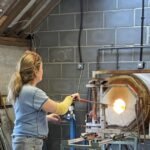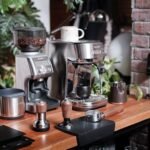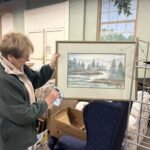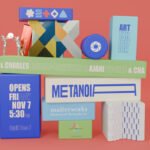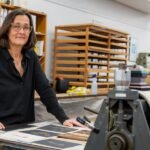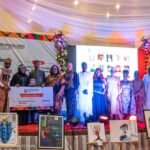
The first solo exhibition of work by the Anglo-Irish artist Barry Flanagan (1941 – 2009) took place at the Rowan Gallery, London in 1966, the month he completed his studies at Saint Martins School of Art (now Central Saint Martins). It occurred simultaneously with Claes Oldenburg’s exhibition at Robert Fraser Gallery. Critics picked up on shared concerns with soft sculpture, and Paul Overy pointed out that Flanagan’s work was intriguing in that it looked soft, but in fact, was hard.1 The exhibition included anthropomorphically shaped sculpture made from plaster filled fabric bags, pieces hanging from the ceiling, and a pile of sand poured directly onto the carpeted floor. He “wanted to project the show as if in [his] normal working situation.”2
When Flanagan exhibited at the Haus Lange Gallery in Krefeld, Germany he spent two weeks in August 1969 onsite, making and installing the works. Materials included hazel sticks, plasticene, canvas and sand and light; day light as well as projected light as sculptural components. Works were titled by date of creation or by medium of production (three space rope sculpture 69, 1969 and a group of four light works named daylight light piece 1, 1969, daylight light piece 2, 1969, and so on).
A month later Flanagan was in New York to install an exhibition at the Fischbach Gallery where he continued to make works in situ including new iterations from the work shown in Germany. He included two new light works made by daylight and projected light over a rectangular frame of brown paper, on the wall. A catalyst in the incorporation of sculptural approaches to conceptual art practice, Flanagan worked most often in an ephemeral mode. He remarked:
“The convention of painting always bothered me. There always seemed to be a way of painting. With sculpture, you seem to be working directly, with materials and with the physical world, inventing your own organisations.”3
Today, photographs preserved in Flanagan’s archive allow glimpses of how original works were created and installed in context with their surroundings, and serve as guides for understanding and recreating these conceptual sculptures in the present day.
Endnotes
- Overy, Paul. ‘The Listener.’ August 18, 1966.
- Baro, Gene with Barry Flanagan. “Sculpture made visible” Studio International, October 1969, (pp. 122 – 125), 125.
- “Sculpture Made Visible,” 122.

